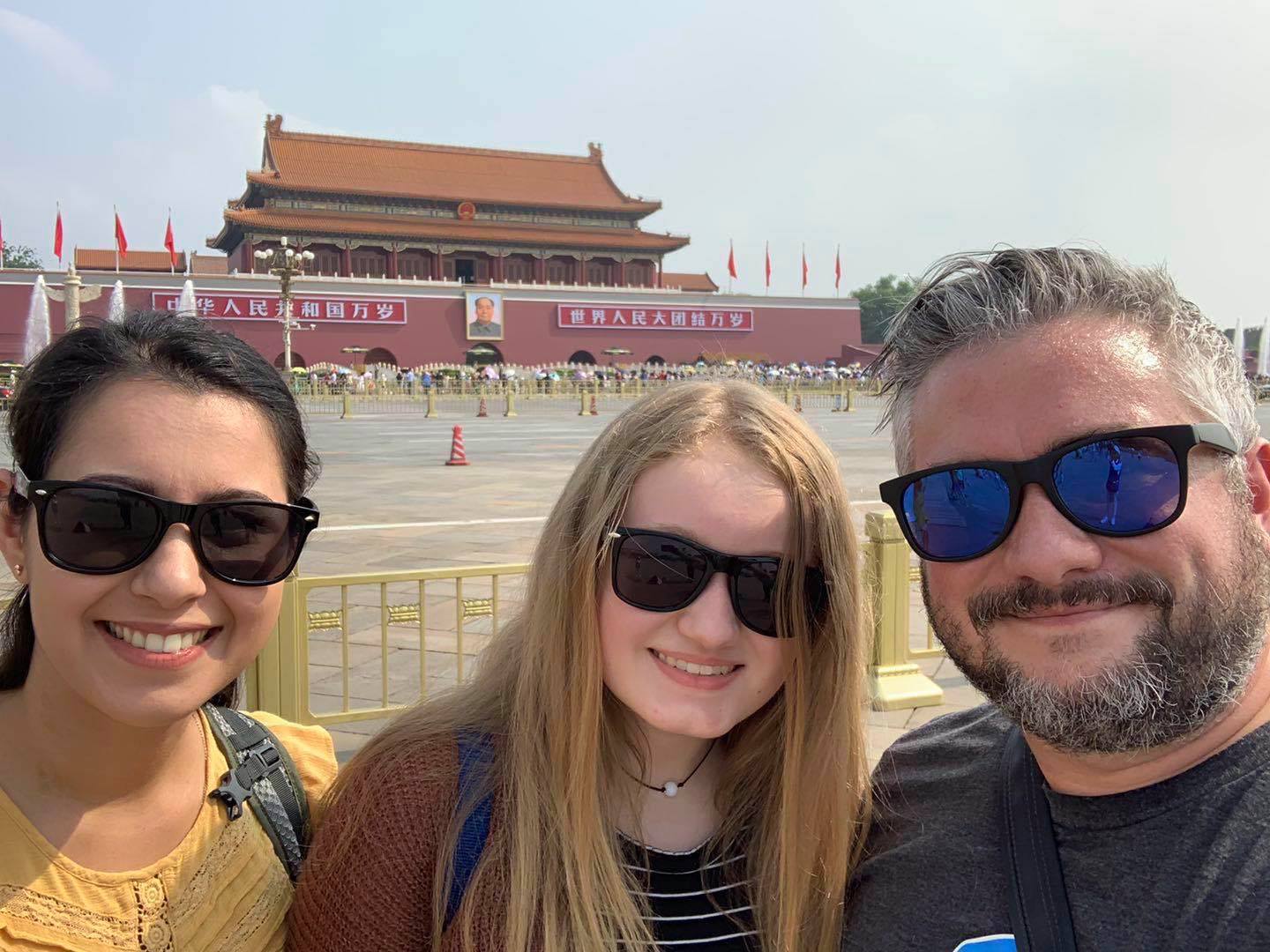We were picked up at our hotel by a private tour guide and driver in an air conditioned van for a full day of Beijing sightseeing.
Our day started at the nearby Tiananmen Square, which despite being one of the largest public squares in the world, was packed with Chinese tourists. All 80,000 tickets for the day were sold out in advance.

To maintain order and ensure security we were made to go through multiple security checks before entering the square. Just in case you don’t already know, there’s little privacy in China. We quickly grew used to showing our passport and having our bags scanned and bodies patted down at the entrance of every attraction. Every train station in the country has metal detectors and bag scanners, and our hotels kept photocopies of our passports.
Shortly after entering the square we quickly became aware that we were an oddity. I would guess that 1% of people in the square were westerners. Poor Geneviette with her beautiful blonde hair, and pale white skin, was like a celebrity amongst the sea of dark haired Chinese visitors. They were so fascinated they asked to take photos with us, and of course after one, more noticed and wanted photos. Eventually our tour guide told them to go away. G was mortified.

I should note that Beijing architecture is very different to what we are used to in America. The buildings around us were tall, boxy, and often gray. There are government officials posted everywhere in the city, standing just a few meters apart, and keeping a keen eye on hundreds of thousands of people.
At the square the Chinese flag is guarded by three officers representing the army, navy and airforce. It is a ceremony that is very similar to the fallen soldier guard in Washington D.C.
Our guide told us that Tiananmen Square is the most popular tourist destination for Chinese people, and far more revered than even the Great Wall. It was the site of the 1989 student protest massacre, military displays and parades. Essentially the site inspires a great sense of nationalism and is a once-in-a-lifetime experience for many of its visitors. The massacre is a highly contentious and censored topic and I highly recommend people read about it.

Although our guide did a good job explaining the significance of Tiananmen Square, I must admit to forgetting much of it. It was just so overwhelming to be surrounded by thousands of people. Little did we know that this would be nothing compared to our experiences in cross-country train stations.
The square is across the street from Forbidden City, also known as the Palace Museum. So when we were done walking around the square we used an underpass to get to there.


It has a very compelling entrance, with a large painted portrait of Mao Zedong’s face hanging above the South Gate. Mao Zedong was the leader of the victorious army, and the founder of the People’s Republic of China. He is greatly revered and beloved of the Chinese people. It is thanks to him that China is the communist country it is today.




Of course, the Palace Museum is not so much about Mao as it is about the royal dynasties who preceded him. It was the imperial palace of China for five centuries (500 years!).
I cannot imagine visiting this place without an English speaking tour guide. To say it was large, and busy, would be an understatement. It is 72 hectares and has around 980 buildings. We walked from one end to the other and it took us about 2 hours with few stops and a lot of brisk walking.

Our guide told us about many symbolic features in the design, and the history. It was overwhelmingly beautiful and impressive. I am fairly certain the Brits are royalty-lite after what we saw at this palace.

The sun and humidity were not our friends, and we were beat by the time we made it through.



Thankfully we had a nice 1 hour air conditioned drive to a restaurant near the Great Wall of China. It was nice to take a break from the outdoors.
Our restaurant food was good, but what was more memorable was our first experience with Chinese “toilets”. Geneviette and I were extremely nervous to use these hole on the floor bathrooms where you need to grab your toilet paper from the dispenser near the sinks, before heading to your cubicle, squatting, doing your business, throwing your used toilet paper into the trash and flushing your “toilet”.
All in all, it’s not a terrible way to relieve yourself. My biggest problems are needing to hold onto the bottom of the door because I have balancing issues and the strong pee smell. To be fair, the latter is more due to the bathroom being dirty.
Finally, after lunch we went to the Great Wall of China! We chose to visit the Mutianyu section of the wall, which is less crowded than the more popular Badaling section, but still very beautiful. Apparently the Mutianyu section has more of the original wall, whilst Badaling is largely a restored section, so less authentic.
We paid extra to take a chairlift up to the wall, and then a toboggan on the way down. The scenery was picturesque but still there was a little bit of smog that kept the view from being perfectly clear.
The cicadas chirped loudly and the chestnut trees brushed against our feet as the chairlift pulled us up toward the wall. I felt so excited seeing it come closer into view. There’s so much expectation surrounding iconic places like this and it did not disappoint.
We jumped off at the end and quickly walked up to stand on the Great Wall of China. It is very steep and the steps are smoothed out in places from so many visitors that they can be a bit slippery.



The views are equally as beautiful as the wall, with the mountains in the distance, and stunning wildflowers growing up against the wall.


We took tons of photos and our tour guide showed us how to tell the difference between the original and the restored parts of the wall.

Eventually it was time to go and we hopped on the toboggan for a fun ride down the mountain back to our van. Once back at our hotel we were so exhausted and jet lagged we passed out at 4pm.




